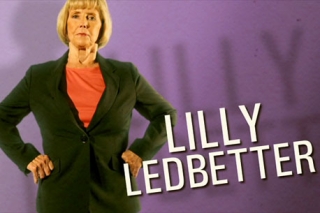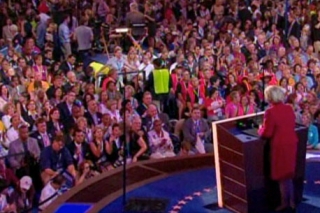About the Film
Gadsden, Alabama is home of the Noccalula Falls and the Broad St. Bridge. It’s also home to a Goodyear Tire plant … and a hardworking grandmother whose fight for equality would take her from the factory floor, to the Supreme Court, and all the way to the White House.
Lilly Ledbetter didn’t set out to be a hero. For almost 20 years, as an area manager – much of that time the only female manager at the plant – she supervised the making of tons of radial tires, managed the men who made them, won awards for her skills, and loved her job. After almost 20 years she was about to quietly retire.
Then one day, just before starting a 12-hour shift, she found handwritten note in her mailbox. It was stunning: a list of salaries that included Ledbetter’s and those of some male colleagues. It turned out that the entire time she’d worked at the Goodyear plant, most of two decades, she’d been paid less – substantially less – that her male counterparts. Not only that, but her pension was tied to her salary, meaning that for the rest of her life, Ledbetter would get less – substantially less – that her male colleagues. “Now if that’s not discrimination,” Ledbetter says, “I don’t know what it is.”
Ledbetter sued and a jury agreed, awarding her over $3 million. Goodyear appealed the verdict and for years the case wound its way through the court system. In 2007, the case reached the United States Supreme Court – nearly a decade after it was originally filed. In a 5-4 decision, the Court ruled in Goodyear’s favor. Lilly Ledbetter had lost.
Even though that meant Ledbetter could never recover the lost pay and pension for herself, that didn’t mean she gave up fighting for others. She testified at Congressional committee hearings, appeared at political rallies, gave interviews to the media, and even spoke at a national political convention. Congress heard her and sent a bill to the White House that would prevent anyone else from being treated the way Lilly Ledbetter was. In January of 2009, The Lilly Ledbetter Fair Pay Act became the first law signed by President Obama.
“If an individual believes and got the grit that it takes,” Lilly Ledbetter explains, “they can stand up and continue fighting and make a difference.”
Image Gallery
[Not a valid template]
Credits
Writer, Producer and Narrator, Robe Imbriano
Associate Producer, Gregory Blanc
Editor, Marc Tidalgo
Graphics Animators, Victoria Nece and Hiroaki Sasa
Photography, Edward Marritz and Daniel O’Shea
Production Associate, Andy Ogden
Consultant, María E. Matasar-Padilla
Coordinating Producers, Christina Lowery and Heidi Christenson
Sound, Mark Mandler and Derek Johnston
Music, Ben Decter and Gavin Allen
Additional Field Production, Carla Denly
Additional Graphics, Tristian Goik
Interns, Andrew Mangino and Carla Altaras
Production Accountants, Mara Connolly and Andrea Yellen
Assistant to the Executive Producer, Lauren Mitte
Senior Producer, Kayce Freed Jennings
Executive Producer, Tom Yellin



